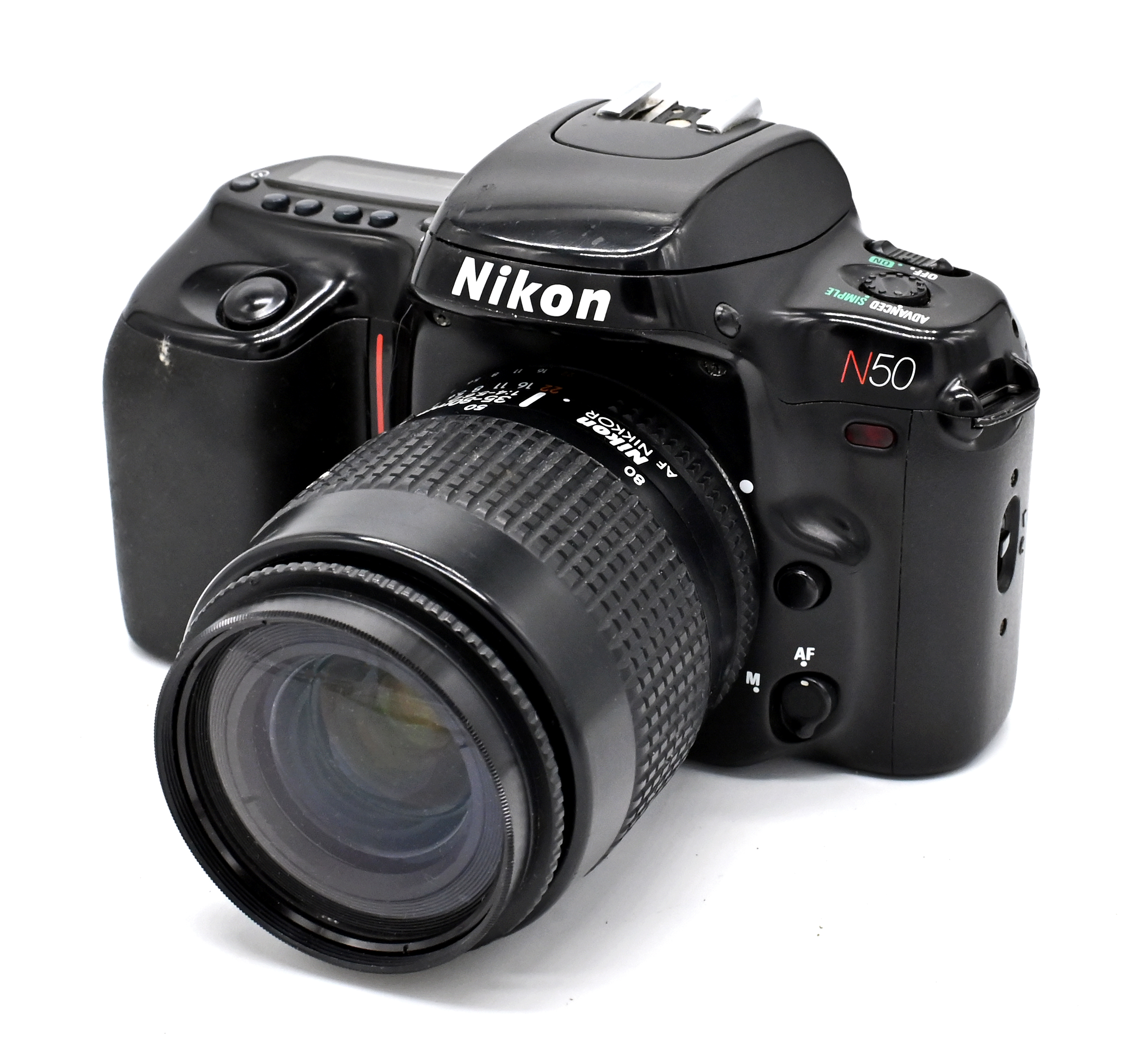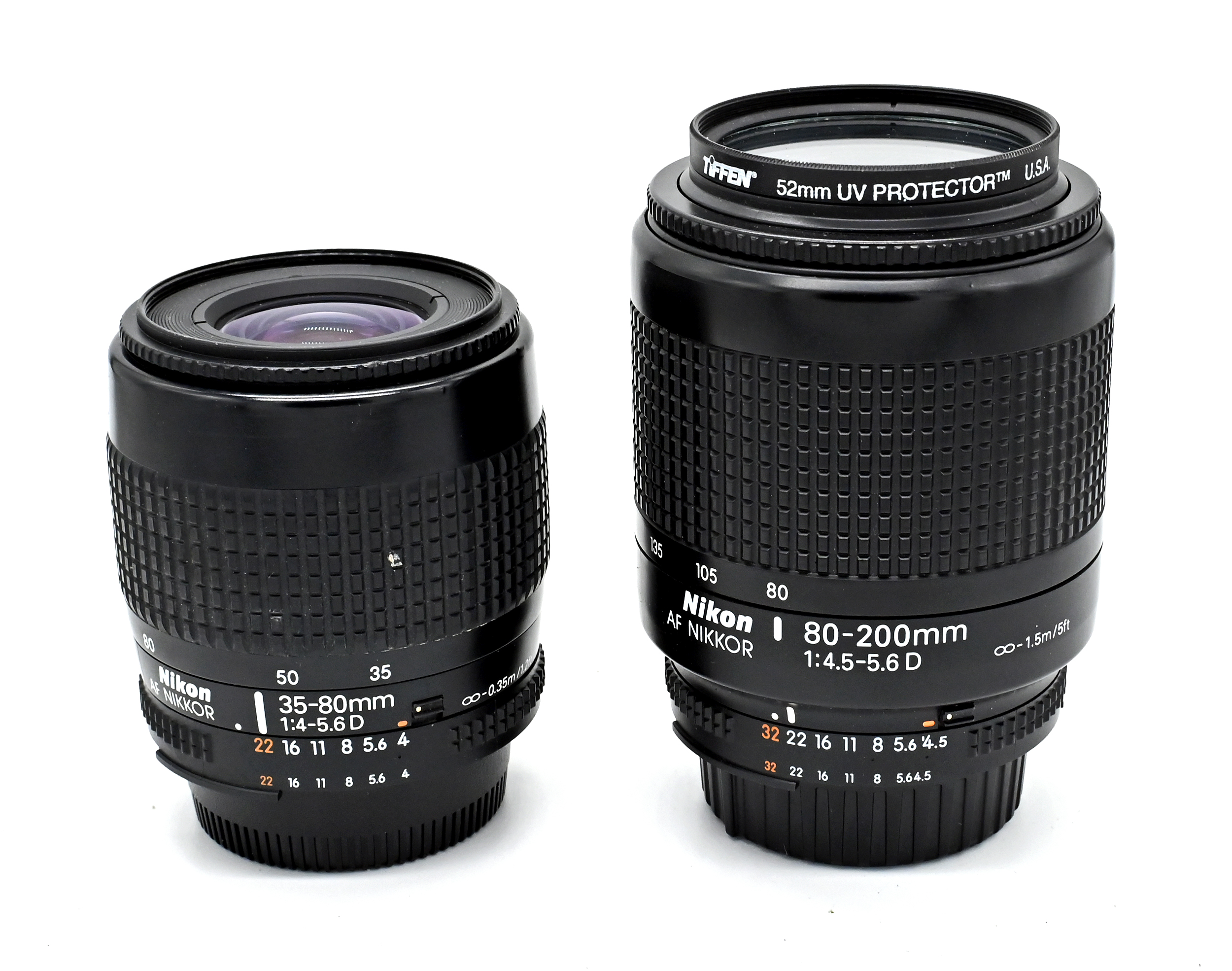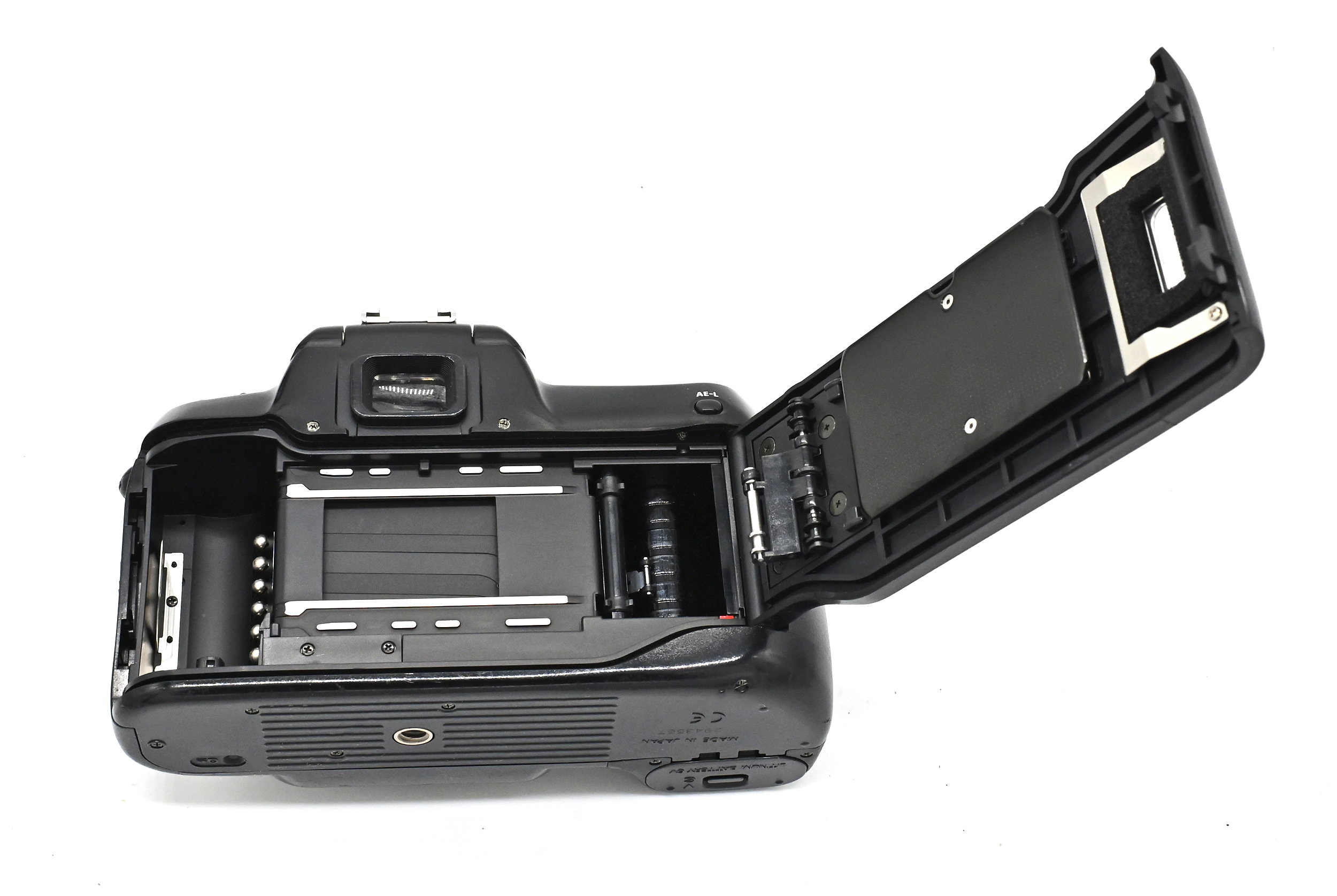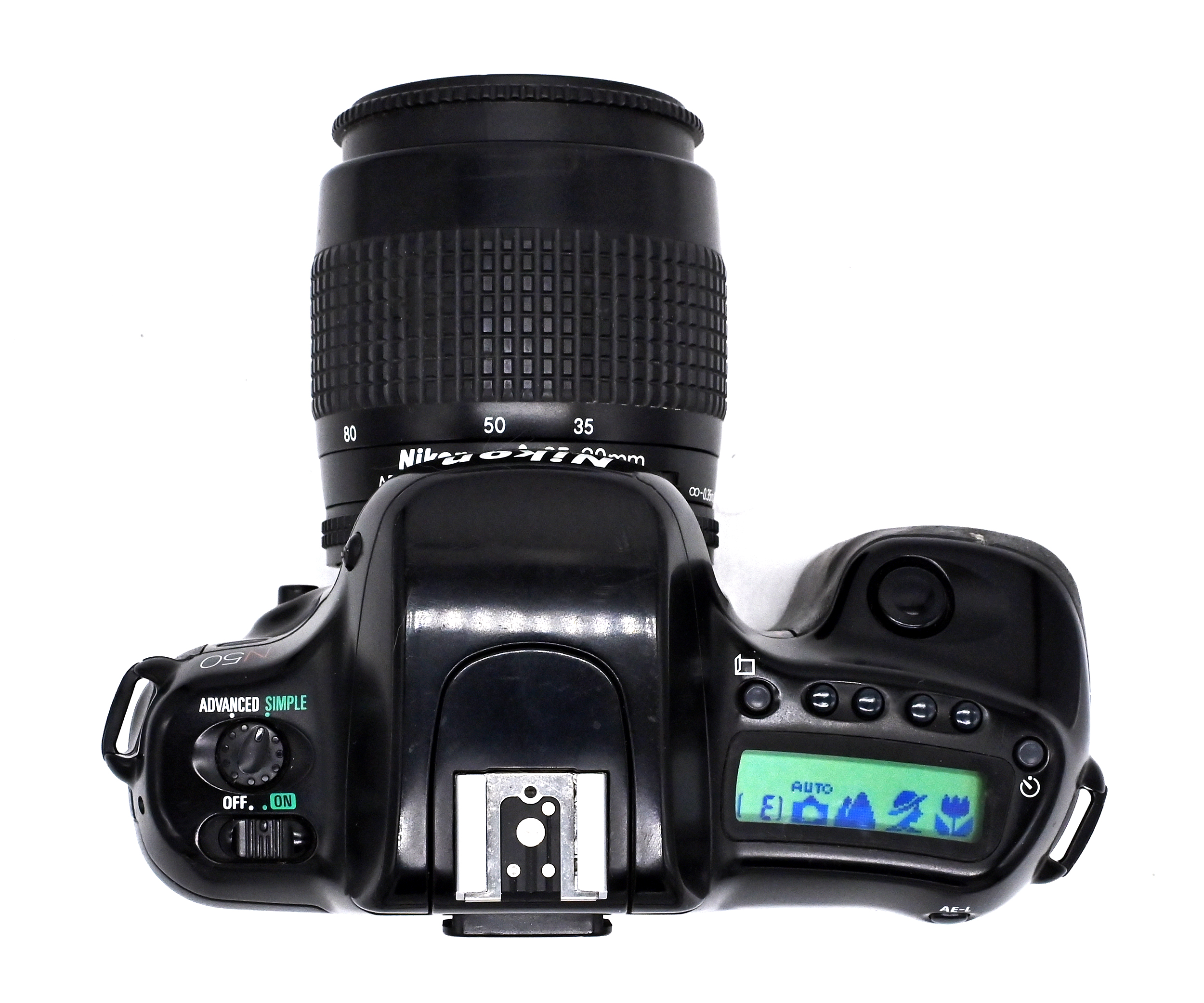
The Nikon N50 (F50) was an entry-level autofocus camera body produced from 1994 until 1998, when it was replaced by the N60 (F60). Compared to the universe of Nikon autofocus SLRs of the 1990s and early 2000s, the N50 has somewhat limited capability and awkward interfaces. Given the existence of numerous, superior, and affordable alternatives, is there any case for the N50 today? Probably not.
From the introduction of consumer autofocus SLRs during the late 1980s until their general demise in the early 2000s, the market was incredibly competitive and all models radically improved through the era in all respects, most notably in autofocus speed and accuracy. Unfortunately, Nikon had to play some serious catchup in this segment to Canon, which was introducing some fine SLRs with faster autofocus speed and accuracy. Starting in 1986 with the N2020 (F-501), Nikon produced a series of advanced consumer autofocus cameras: the N4004 (1987), the N8008 (1988), the N4004S (1989), the N6006 (1990), and the N8008S (1991). These models were followed by the well-featured N90 (F90) in 1992, and then by the updated N90s (F90x) in 1994. The N90s was clearly and purposefully the best of the bunch and an important stepping stone between the professional Nikon F4 (1988) and the F5 (1996).
Alongside the introduction of N90s, Nikon introduced two consumer-level cameras for 1994: the N70 and the N50. The N50 was often packaged with two “kit” zoom lenses: the 35-80mm f/4-5.6 AF-D and/or a 80-200mm f/4.5-5.6 AF-D. The general consensus is that the 35-80mm is not a very good lens, but the 80-200mm has its fans. The N50 was replaced with the more-intelligently designed N60 in 1998 and then by the further improved N65 in 2001.

Specifications
Here are the compared specifications of the 1994 N90s, N70, and N50.
| N90s | N70 | N50 | |
| Shutter Speeds | 30 sec – 1/8000 | 30 sec – 1/4000 | 30 sec – 1/2000 |
| Viewfinder Mag. | 92% / .78x | 92% / .77x | 90% / .78x |
| Motor Drive | Load / Advance / Rewind | Load / Advance / Rewind | Load / Advance / Rewind |
| Auto Focus | CAM246 Module | CAM274 Module | AM200 Module |
| ASA Range | DX (25-5000); Manual (6-6000) | DX (25-5000); Manual (6-6000) | DX (25-5000); Manual (6-6000) |
| Battery | 4 x AA | 2 x CR123A | 2CR5 |
| Weight | 755g | 585g | 580g |
| Flash Sync | 1/250; TTL | 1/125; TTL | 1/125; TTL |
| Metering | Matrix / Center / Spot | Matrix / Center / Spot | Matrix / Center |
| Exposure Modes | P / A / S / M | P / A / S / M | P / A / S / M |
| Full Lens Compatibility | AF; AF-D; AF-S; AI-P | AF; AF-D; AF-I; Non-G AF-S | AF; AF-D |
| Partial Lens Compatibility | AI; AI-S | AI; AI-S | AI; AI-S; AF-S; AF-I |

Operation
While certainly capable of taking great photos and with a variety of useful features, the N50 is nevertheless hobbled by a poor user interface and limited capability to use both manual focus lenses and Nikon’s later and better AF lenses. Even in its class of entry-level cameras, later models like the N75 and N65 just blow it away. Given that, and without going exhaustively through all of its features, let’s look at what it can and cannot do.
Limited Nikon Lens Compatibility: The N50 was designed to work primarily with Nikon’s contemporary line of AF and AF-D lenses. While there are some winners in this line-up, especially the professional zooms and the prime telephotos, Nikon’s later AF-S lenses were largely a significant improvement. While the N50 cannot autofocus either AF-S or AF-P lenses because of a lack of appropriate interfaces, it still can operate them in all shooting modes with a focus-assisted manual-focus mode. More importantly, the N50 cannot meter or focus-assist the AI or AI-S line of lenses.
Viewfinder: The N50 seems to have borrowed the viewfinder design of the Nikon F4, with its signature green LCD screen at the bottom displaying the shutter speed, aperture, and focus assist indicators. Unlike the F4, where the illuminator has to be switched on, the N50 illuminator always lights up when the exposure meter is activated. The 92% frame coverage with .78x magnification is not that great but similar to the N90s and N70.
Autofocus: The N50 uses the same 1988 autofocus module as the Nikon F4. The AM200 is relatively fast and accurate but had certainly been long-surpassed by 1994. The autofocus from the screw drive is fairly noisy. A half-press of the shutter button will trigger the autofocus and turn on the exposure meter. To lock the exposure, one must press an external AE-L button on the back upper-right of the body. The N50 has both a single and continuous autofocus mode. The continuous mode remains fairly primitive by modern autofocus standards.
Exposure Metering: When using AF, AF-D, AF-S, or AF-I lenses, the N50 automatically defaults to a now-primitive six-segmented matrix light metering. When switching to manual exposure mode, the N50 will switch to center-weighted metering.
TTL Flash: Apart from a fairly useless built-in pop up flash, the N50 can use the world of Nikon TTL flashes contemporary to it and has a fairly average x-sync speed of 1/125. The N50 can use Nikon TTL flashes for automatic daylight fill.
Other Features: The N50 had a variety of other standard features, like an integrated motor drive and automatic film loading and rewinding,
Shooting Modes: The N50’s most significant shortcoming is its often-confusing and unnecessarily complicated shooting modes. Instead of using what ended up becoming “standard,” a top mounted LCD readout and rotating dials moved by one’s fingers, the N50 uses a series of buttons and LCD readouts consisting of pictures, numbers, and letters that on a good day would take some getting used to. The primary modes are labelled “Simple” or “Advanced.”
In “Simple” mode, the camera gives you four pre-set options to select on the LCD menu on the top right of the body: (1) “General Purpose Program” (camera icon); (2) “Landscape” (mountain icon); (3) “Portrait” (lady in a hat icon); and (4) “Close-Up Program) (a flower icon). No technical exposure information (shutter speed or aperture) is displayed in the viewfinder. However, there is an autofocus confirmation circle and the flash icon will blink if there is not enough light.

In “Advanced” mode, to choose standard exposure modes (P / A / S / M), the user selects with a button under the appropriate letter. If P is selected, there are four additional pre-programmed modes to choose from: (1) “Sport Program” (runner icon); (2) “Night Scene Program” (buildings with moon icon); (3) “Motion Effect Program” (a runner with wind icon); and (4) “Silhouette Program” (setting sun with palm tree icon).
By selecting “A,” you can use the top controls to select your preferred aperture without having to change the settings on the lens itself. If insufficient light exists, the viewfinder will blink the “flash” icon. By selecting “S,” you can use the top controls to select a preferred shutter speed and the camera will set the appropriate aperture. If your shutter speed is too high or low for the lighting, the viewfinder will signal “Lo” or “Hi.” By selecting “M,” you can use the top controls to manually set a shutter speed and aperture. If your manual settings disagree with the camera’s meter, the viewfinder will tell you in +2 / -2 how much you are off and also blink the flash icon if necessary.

Conclusions
Because N50s are basically free today, it is difficult to find anything wrong with the camera at that price point. I think that the N50 is best used in a standard “Program” or “Aperture Priority” modes, which allows the camera to fully function so you can focus on the shot, and not trying to figure out how to change the settings on the fly. The inability to autofocus the much better and quieter AF-S lenses is a real downer, especially since, save for the 1998 N60, Nikon would never make another 35mm film SLR that could not autofocus them. The inability to effectively use manual focus lenses is also a bummer. You just have to deal with the pain of its relatively loud autofocus mechanism and one of Nikon’s earliest autofocus modules.
Instead of the N50 for an easy-to-use, entry-level AF Nikon SLR, I would look at the early 2000s N80 (F80) or the N75 (F75). These cameras are much more fully featured, relatively lightweight, and can use virtually every Nikon AF lens ever made. If you have a few more bucks, consider the F100, which has everything you would want in Nikon autofocus camera. Unless a camera like the N50 falls in your lap, I would skip it entirely.
I have one of these cameras and my concensus on the 35-80/4-5.6 AF-D lens is that its actually a really good lens. One of the best kit lenses ive used, Im an expert photographer and have used 50+ film cameras from 1919 up to when they quit making new ones.
The built in meter of the N50 is a really good meter and really accurate and ive even used it as a sort of light meter to check and then put the reading into my other cameras that dont have light meters when I cant be bothered to take out my Sekonic meter. I also have a few digital cameras even though I still mostly shoot film. Including most of Fujis X series cameras. I can say that X series kit lenses are cheap and garbage and low grade plastic and of even lower quality than these kit lenses on older film cameras its kind of sad when modern cameras take a huge leap back.
Wow! It’s awesome that there is a recent review of this camera. Thanks a lot.
My friend just gifted me one of these (N50)
at my request of any 35mm film camera.
I’ve always been a little fascinated by 35mm
Cameras because myself or my parents never owned one and back in the day they and weren’t very affordable for a family of 7
with a modest income.
So I bought a battery and some Ilford b/w 400 film just to get started.
I just dropped off my first roll at Walgreens last night.
I’m not expecting much but, I look forward to see how good or bad my first roll looks.
Thank again
Chris, the 35-80 is really a melon, a good lens is the 28-80G, if being used from F8-F13 aperture. And a real better lens than both of these two, the Nikon 28-70/3.5-4.5D lens, because i’ve had them all, the former two ones are cheapskate.
Via Nikon, the cheapest AF SLR which i can accept, is simply the F60 in black. It’s a no-nonsense, no frills, no extra 35mm AF SLR, with bright all glass pentaprism OVF, which does the trick, for AF-D, AF-G lenses.
A step above is the F65, F75….both not from OVF, and build quality, only feature-wise, and from AF (5 AF Points). Not being a gear snob, but the smallest 35mm Nikon AF SLR i was using, is simply the F80/N80, Downstairs, there are many limitations, loss of custom features, loss of a 2nd dial, and many more things…compromises.
At the end of the day, whatever suits your needs. My bare minimum is the F60/N60 here.
The N50 cannot use G lenses, no aperture ring
Hi, I wanted to find out if it is worth keeping the Nikon N 50 and N 70 cameras. I was planning to sell them. Do you recommend a good place to sell?
I also own a Nikon D 3200, and was planning to keep that camera.
I would like your advice on where to get the best price on these. I am very new to reading the information on lenses.
Give them to a photo club or photograph class. Last N50 I bought was in perfect condition and sold for less than $7
I used a Nikon F50 as a professional social photographer from around 95 to the early 2000’s, I had the excellent Nikkor 28-80 AFD lens on it and a Mecablitz 45 flash with a control SCA that enabled TTL flash metering and assisted auto focus in dark conditions such as wedding receptions and nite clubs.
It still works perfectly although the rubber grips have gone a bit sticky.
Despite its low cost it is a great camera and on rare occasions I had prints made from it at 20×30 that didn’t look half bad.
[…] from Nikon. Alternatively Butkus also carries it. The camera has been reviewed by on Down the road, davidde.com, ACP and […]
The N50 was my first real camera, purchased on the fly before embarking on a 3000 mile bike tour through Alaska, Canada, and Washington. It worked fine for a point-and-shoot, and I ran 13 rolls of Kodak Max 400 through it, but as I started to delve into the art of photography, I grew to hate it with a passion. I eventually traded it and the 35-80mm lens towards the purchase of an FM2N, which I considered to be a substantial upgrade, considering the lack of compatibility between the N50 and any non-AF lens. I still have and cherish the FM2N, and eventually added an F801s with MF-21 back and an F4 with MF-23 back. Every time I see an N50/F50 I cringe, hard; it’s roughly an overcomplicated equivalent to a disposable, offering only a zoom and film preference into the mix.
[…] références : https://davidde.com/2020/02/23/review-the-nikon-n50-f50/, https://www.mir.com.my/rb/photography/companies/nikon/htmls/models/specroom98/f50/f50spec.htm, […]
[…] Nikon N50 review on Davide.com […]